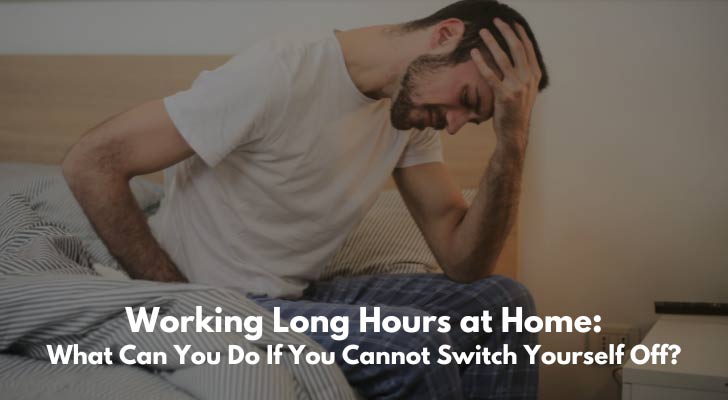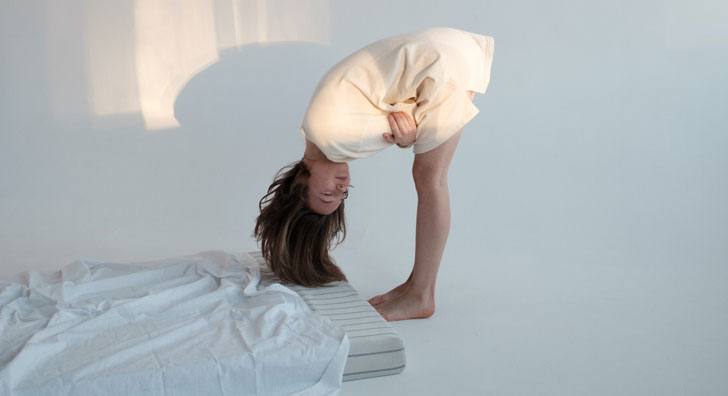For many years, those who run an online business at home have been suffering from not being able to switch themselves at home at night. Do you find it hard too, after a long day of working from home? Do you feel like your work-life balance has gone out the window?
Separating our personal and professional lives is a really difficult thing to do. So take a look at some tips and tricks for switching off after work when you can't seem to do so naturally.

Did You Know?
- Increased Working Hours: 41% of remote workers reported working longer hours than they did in the office.
- Burnout Rates: Remote workers experienced a 25% higher rate of burnout compared to in-office employees.
- Difficulty Unplugging: 70% of remote employees struggle with switching off from work in their personal time.
- Work-Life Balance: 60% of people working from home find it more challenging to maintain work-life boundaries.
- Physical Health Concerns: 35% of telecommuters reported a decrease in physical health, attributing it to longer work hours.
The Reasons You Cannot Switch Yourself Off
When you've been working long hours at home, you may feel physically tired at the end of the night, but your brain can be in a trance state because of all the unfinished work stuff. When you cannot switch yourself off when going to bed, the most obvious reasons are;
- Stress/worry and
- Physical discomfort (bad mattress, pillows, noise, etc.)
Here are some other common factors that can affect your ability to unwind and relax:
- Overstimulation: Using electronic devices, watching intense shows, or working... You keep stimulating your brain at bedtime.
- Lack of winding-down time: If you go directly from a busy schedule to bed, your mind may still be in an active state.
- Irregular sleep schedule: Inconsistent sleep patterns can disrupt your body's natural sleep-wake cycle, making it harder to fall asleep and wake up feeling refreshed.
- Blue light exposure: The blue light emitted by electronic devices can suppress the production of the sleep hormone melatonin and interfere with your sleep quality.
Did You Know?
- Mental Health Impact: 45% of remote workers said their mental health has been negatively impacted by the isolation of working from home.
- Stress Levels: 38% of those working from home reported increased stress levels.
- Sleep Disturbances: 27% of home workers have experienced sleep issues due to work-related stress.
- Lack of Exercise: 50% of remote workers say they exercise less frequently since working from home.
- Ergonomic Challenges: 65% reported new or increased neck, back, or shoulder pain since starting to work from home.
You May Have a "Eustress"
You love what you do and enjoy the freedom of working from home. You receive no complaint from anyone. You have zero anxiety. You don't think you're stressed but you cannot switch yourself at night. Then you may have eustress.
Eustress is a positive stress that can have a beneficial and motivating impact on our lives. It's like a good kind of excitement or motivation that we feel when we face challenges or opportunities that we find interesting or rewarding.
Let's say you have a passion for a particular service, and you see this as a chance to turn your passion into a successful new venture. This situation can generate eustress.
You are excited about all sorts of possibilities and you feel motivated to learn new skills, such as marketing or bookkeeping, to help your business thrive. The challenge of building something from scratch and the potential for financial independence can give you a sense of enthusiasm and determination.
The satisfaction of seeing your business grow further reinforces the eustress. This positive stress can enhance your creativity, problem-solving abilities, and overall sense of fulfillment.
The Long-Term Effects of Not Switching Yourself Off

The possible consequences of not being able to switch yourself off are:
Sleep deprivation
Lack of sufficient sleep can impair cognitive function, weaken the immune system, increase the risk of accidents, and contribute to various health problems like cardiovascular issues, obesity, and diabetes.
Mental health issues
Your brain needs time to relax, process information, and engage in activities that promote mental well-being. Over time, the absence of this downtime can lead to burnout, reduced productivity, and overall dissatisfaction.
Impaired cognitive function
Prolonged periods of work without sufficient rest can impact your cognitive abilities. Your attention span, memory, decision-making skills, and creativity may suffer. Lack of quality sleep impairs your ability to concentrate and retain information.
Physical health problems
Chronic fatigue can weaken the immune system, making you more susceptible to infections and illnesses. It may also increase the risk of developing chronic conditions such as heart disease, high blood pressure, and metabolic disorders.
Relationship strain
Continuous work without breaks can negatively affect your relationships. You appear to be detached from your loved ones, making them feel they're neglected. This will strain relationships and hinder your overall well-being even more. Vicious circle, that is.
Did You Know?
- Social Isolation: 33% of remote workers feel isolated or lonely during the workday.
- Communication Overload: 58% feel overwhelmed by the constant barrage of communications (emails, video calls, chats).
- Performance Anxiety: 40% of remote workers feel pressure to prove they are working hard and fear underperforming.
- Technological Stressors: 30% of home-based employees cite technology issues as a significant source of stress.
- Lack of Routine: 42% struggle with maintaining a regular work routine at home.
Create a Strict Daily Routine
Here's how you can create a strict daily routine - including setting aside time for breaks away from work and incorporating regular physical activity in your day. This is just an example:
6:00 AM - Wake up
- Start your day with a refreshing shower and get dressed.
6:30 AM - Morning Meditation
- Spend 10-15 minutes practicing mindfulness or meditation to set a positive tone for the day.
7:00 AM - Breakfast
- Enjoy a healthy and nutritious breakfast to fuel your body.
7:30 AM - Preparation
- Use this time to relax, listen to music, or read. Otherwise, use it for any necessary preparations for the day.
8:00 AM - Work
- Begin your workday, focusing on your most important tasks and projects.
10:00 AM - Short Break
- Take a 10-15 minute break away from your desk. Stretch, go for a short walk, or do a quick mindfulness exercise to refresh your mind.
12:00 PM - Lunch Break
- Take a proper break for lunch. Step away from your work area and enjoy a balanced meal. Use this time for relaxation or socializing.
1:00 PM - Work
- Resume work, addressing pending tasks and attending meetings as required.
3:00 PM - Afternoon Break
- Take another short break to recharge. Engage in light stretching exercises, have a healthy snack, or take a quick walk outside to rejuvenate your energy.
5:00 PM - End of Work
- Wrap up your workday and sign off. Make a conscious effort to leave work-related matters behind.
5:30 PM - Physical Activity
- Engage in regular physical activity, such as going for a jog, attending a fitness class, or practicing yoga. Choose an activity you enjoy and that suits your fitness level.
7:00 PM - Personal Time
- Dedicate this time to activities you enjoy outside of work, such as hobbies, spending time with loved ones, reading, or watching a movie.
8:30 PM - Wind-Down Routine
- Establish a wind-down routine to prepare your mind and body for sleep. This may include activities like reading a book, practicing relaxation techniques, or taking a warm bath.
9:30 PM - Bedtime
- Aim for a consistent bedtime that allows you to get adequate sleep, ideally 7-9 hours. Ensure your sleep environment is comfortable, dark, and quiet.
No matter how busy your work schedule is, don't forget to take breaks, make sure you have physical exercise every day, and make sure you have a healthy work-life balance.
Did You Know?
- Increased Screen Time: Remote workers report a 35% increase in screen time, contributing to digital fatigue.
- Workspace Inadequacy: 47% do not have a dedicated workspace at home, affecting their posture and concentration.
- Distractions at Home: 60% of people working from home face more distractions than at the office.
- Fear of Job Loss: 25% of remote employees feel more anxious about job security.
- Childcare Challenges: 55% of working parents find juggling childcare and work responsibilities highly stressful while working from home.
If You Find Yourself Unable To Switch Off
Even if you have a perfect schedule, when you can't sleep, you can't sleep, can you? Some suggest that you should get up and go back to your desk even at 2 am. That's not really ideal when you feel physically so tired but your head is in some kind of euphoric state.
So here are some techniques that you can use - none of them is magic, but try all of them and hopefully at least one of them will work for you.
1. Read a Physical Book

Smartphones, tablets, and computer screens emit blue light, which can interfere with the body's natural sleep-wake cycle. Blue light exposure in the evening or before bedtime can suppress the production of melatonin, a hormone that helps regulate sleep.
Reading a physical book or using an e-reader with an e-ink display, such as a Kindle, does not emit blue light. The reflective display technology used in e-ink devices mimics the appearance of ink on paper, making them more similar to traditional printed books.
It's a good practice to establish a habit of reading from a book or e-reader with an e-ink display if you prefer to read before bed.
If you still prefer using electronic devices, you can consider enabling the "Night Mode" settings on your smartphone or tablet. The settings reduce the amount of blue light emitted by the screen.
There are also apps available that can filter out blue light or apply a warmer color temperature to the screen to reduce its impact on sleep.
2. Deep Breathing Technique (In Bed)
Deep breathing is a relaxation technique will help you calm your mind. Follow these steps:
- Step 1 - Relax: Lie down on your back, close your eyes, and place one hand on your abdomen.
- Step 2 - Take slow, deep breaths: Inhale deeply through your nose, allowing your abdomen to rise as you fill your lungs with air. Exhale slowly through your mouth, allowing your abdomen to fall as you release the breath. Imagine that the air keeps entering and leaving your body.
- Step 3 - Count your breaths: To help maintain focus, you can count your breaths. For example, count to four as you inhale, hold for a brief moment, and count to four as you exhale. Adjust the count to a rhythm that feels comfortable for you.
- Step 4 - Repeat and relax: Continue this slow, deep breathing pattern for several minutes, allowing yourself to relax and let go of any tension or racing thoughts.
Deep breathing is good because it stimulates the “parasympathetic” nervous system, which makes your body relaxed naturally. This leads to a decrease in heart rate, blood pressure, and muscle tension, promoting a state of relaxation.
3. Progressive Muscle Relaxation Technique
Progressive muscle relaxation is a technique used to release physical tension and promote relaxation throughout your body. It involves systematically tensing and then relaxing different muscle groups, starting from your toes and moving up to your face, while lying in bed.
To practice progressive muscle relaxation, follow these steps:
- Step 1 - Find a comfortable position: Lie down on your back in a comfortable position, close your eyes, and take a few deep breaths to relax.
- Step 2 - Focus on each muscle group: Start by focusing on your toes. Curl them tightly and hold the tension for a few seconds.
- Step 3 - Release the tension as much as you can, so you feel that your muscles are relaxed completely. Pay attention to the sensations of tension and relaxation in your toes.
- Step 4 - Move up through your body: Gradually move up through your body, tensing and then relaxing each muscle group. Progress to your feet, calves, thighs, buttocks, abdomen, chest, back, hands, arms, shoulders, neck, and finally, your face. Pause briefly in each muscle group to notice any tension and then consciously release it.
- Step 5 - Maintain awareness and relaxation: As you progress through each muscle group, keep your attention focused on the sensations of tension and relaxation. Take your time with each muscle group and try to let go of any unnecessary tension you may be holding.
By systematically tensing and relaxing each muscle group, you increase your awareness of the physical sensations in your body and develop a deeper sense of relaxation.
4. Visualization/Imagery Exercises
The exercises involve imagining the details, sounds, and sensations of this place, and you can shift your focus away from racing thoughts and induce a sense of relaxation. Here's how you practice:
- Step 1 - Find a comfortable position: Lie down in a comfortable position, close your eyes, and take a few deep breaths to relax.
- Step 2 - Choose your peaceful place: Select a location that brings you a sense of tranquility, such as a beach, forest, or garden. It can be a place you have visited before or entirely imaginary.
- Step 3 - Engage your senses: Begin to visualize the details of this place in your mind. Picture the colors, shapes, and textures around you. Imagine the sounds, such as gentle waves, rustling leaves, or chirping birds. Feel the warmth of the sun, the coolness of the breeze, or the softness of the grass beneath you.
- Step 4 - Immerse yourself: Dive deeper into the imagery by engaging all your senses. Imagine the scent of flowers, the taste of the air, or the sensation of your feet in the sand.
- Step 5 - Stay focused and relaxed: As you visualize your peaceful place, let go of any distracting thoughts or worries. Keep your attention on the details and sensations of the imagery. If your mind wanders, gently bring your focus back to the calming scene you've created.

These exercises can help redirect your mind away from stress and induce a state of relaxation. Immerse yourself in the mental experience of a peaceful place, and you can create a soothing environment in your mind.
5. Use a Relaxation App
Hundreds of of relaxation apps are available for free. They offer guided exercises, soothing sounds, or sleep-inducing music that can be accessed without leaving your bed.
They have different features to help you relax, such as guided meditation, breathing exercises, or calming stories.
Audio recordings work similarly but without the need for an app. You can find recordings online or even use a pre-recorded CD or MP3.
Just Accept It
Finally, just accept the fact that you can't sleep. Everyone has bad days and bad nights. Occasional sleep difficulties are normal and part of life.
You must get up early in the morning, but you can't sleep. You'll be too tired tomorrow because of the lack of sleep. So what? When you can't sleep, you can't. Accept it! Maybe you'll have an awesome, long sleep tomorrow night. Be cool about it.
Acceptance can help reduce anxiety and allow your mind and body to relax. You know you are doing your best and therefore trust that sleep will come in its own time.
How I "Finally" Make Over $7,000 Monthly Income
"The most valuable thing I've ever done!"


